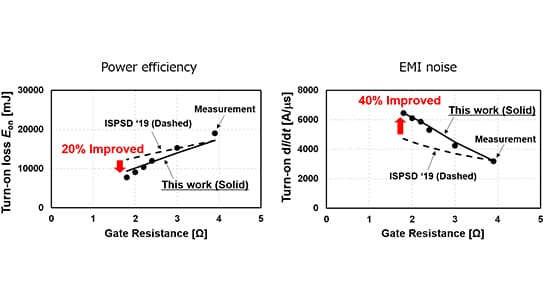Toshiba’s IGBT and FWD Compact Modeling Realizes Highly Accurate Prediction of Power Efficiency and EMI Noise for Multiple External Condition
September 24, 2020
Toshiba Electronic Devices & Storage Corporation
TOKYO--Toshiba Electronic Devices & Storage Corporation (“Toshiba”) has developed a compact model for simulating and predicting power efficiency and electromagnetic interference (EMI) noise in Insulated Gate Bipolar Transistors (IGBT) and Free Wheeling Diodes (FWD). The model can be applied to multiple external conditions, including gate resistance, collector current and temperature, and reproduces measured turn-on switching waveform more accurately than current methods. It and improves prediction of power efficiency by 20% and of EMI noise by 40%. [1]
Details were reported at the IEEE-sponsored International Symposium on Power Semiconductor Devices and ICs 2020 (ISPSD 2020) held online.
Power devices are essential components of inverter and converter circuits. IGBT, which integrate MOS-gate control with bipolar conductivity modulation, are particularly important in high power applications, where they realize high input impedance and low on-resistance. Growth in the electric vehicle, factory automation and renewable energy markets continues to drive demand for IGBT.
In developing IGBT, electron flow and hole flow are important considerations that produce complex switching performance. Accurate circuit simulation is essential to predict power efficiency and EMI noise, as unanticipated EMI noise can damage equipment. Current simulation models do not sufficiently reproduce switching behavior.
Toshiba developed a model that added two parallel sub circuits and a capacitor that shows change in capacitance over time, and presented it at ISPSD 2019. [2] While it improved prediction accuracy, that model does reproduce power efficiency and EMI noise when gate resistance changes. However, gate resistance is a parameter for adjusting power loss and switching speed, and is central to the design of power electronics systems.
Toshiba’s new model adds two functions that solve this problem. First is the ability to change capacitance of the model’s capacitor in the model without changing the model’s structure. Recognizing that that capacitance follows gate resistance, Toshiba formulated and applied a way to change capacitance, allowing the new model to follow changes in gate resistance.
Second, the new model considers not only IGBT but also FWD. FWD are often used with IGBT, and are essential for inverter circuits. The addition of a function to change reverse recovery characteristics [2] following a change of gate resistance allows the new FWD to reproduce measured turn-on switching waveforms more accurately than other models.
The new IGBT and FWD model improves prediction accuracy for power efficiency and EMI noise for multiple external conditions and will contribute to more efficient development of power electronics system using IGBT and FWD.
Improved prediction accuracy

Notes
[1] Comparison of power efficiency and EMI noise in the current model and new model when changing gate resistance from 3.8 ohms to 1.8 ohms.
[2] For details, please see Toshiba’s previous news release: “Toshiba’s IGBT/IEGT Compact Modeling Realizes Highly Accurate Prediction of Power Efficiency and EMI Noise”.
[3] Reverse recovery characteristics occur when a diode transitions from forwarding bias to reverse bias. The flow of reverse recovery current causes blocking time to increase.
Customer Inquiries
Power Device Sales & Marketing Department
Tel: +81-3-3457-3933
* Information in this document, including product prices and specifications, content of services and contact information, is current on the date of the announcement but is subject to change without prior notice.
* Company names, product names and service names may be trademarks of their respective companies.